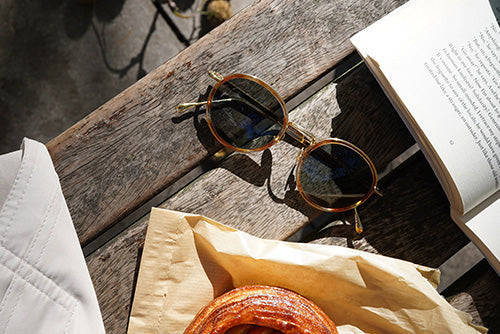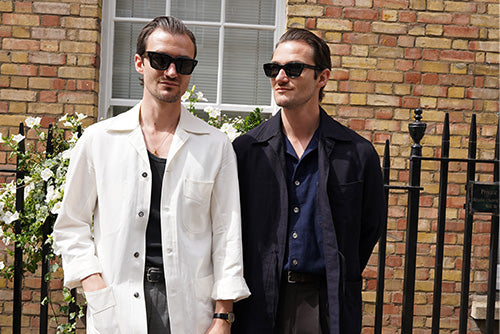Tom Massey, In The Frame
Quality sunglasses are essential for all serious gardeners, so we were happy to help out Tom Massey and his incredible team at this year’s RHS Chelsea Flower Show - keeping the sun from their eyes, and hopefully, easing some of the hard work that went into creating their stunning Avanade Intelligent Garden.
To celebrate, we sat down in the garden with Tom to learn more about it.

Tom, it’s wonderful to be here at the RHS Chelsea Flower Show, and it’s such a pleasure to have the opportunity to speak with you about your work. For those who may not know you, could you introduce yourself, tell us a little about what you do, and what led you down this path?
I'm Tom Massey, I have been a landscape and garden designer now for about 10 years. I originally trained as an animator and had quite a varied career before coming to landscape design, but what I wanted to do was find a career where I could spend time in nature, work with plants, and create really immersive, atmospheric spaces that people could enjoy.

Your gardens often serve as conversation starters for important global issues - from the climate crisis to the refugee crisis In your opinion, how can a mission-driven conceptual garden help shift perspectives and foster greater understanding or empathy toward a cause?
I'm really interested in exploring the tension between storytelling, functional practicality and beauty. I think gardens have a real power to engage people. They're very immersive and emotive, and they can tell a story in a way that is quite unique. Everyone has an experience with nature, a scented plant can bring back memories of a holiday, a loved one, or a lost relative. The garden we did for Water Aid or the garden we did with the Lemon Tree Trust, are telling stories and picking up on big issues such as the global water crisis, and the global refugee crisis, but allowing people to connect through nature and gardening, which is global and universal. I think it's a really powerful medium to tell stories.

On that note, could you walk us through the concept behind The Avanade Intelligent Garden, your latest project at the RHS Chelsea Flower Show, designed in collaboration with Je Ahn?
The Avanade Intelligent Garden is a collaboration with Jay Anne of Studio Weave and Sebastian Cox, who is an amazing furniture maker who has built the mycelium pavilion at the back. This garden is all about the tension and interplay between technology and nature. Urban trees globally are really under threat - you know 1 in 3, don't survive the first year, 50% die before 10 years, and it takes up to 16 years for a newly planted tree to even become carbon neutral.

So we're planting these deficient urban forests that struggle to thrive, but here (in the Avanade Intelligent Garden) we're showing that having a diverse mix of species provides more resilience. We're also very subtly weaving technology into the design, so you'll see on the trees there are these tiny sensors that are monitoring how much that tree is growing, what the temperature is, the humidity around the tree, how much light it's receiving, and then there are soil moisture sensors that are measuring the volumetric moisture levels in the soil. This builds a really interesting picture and allows you to interact with the trees.

We've built in an AI element that creates a way to actually have a conversation with those trees - a language-based conversation. You can type a question and the tree will respond based on the data and the training data that we fed the AI. It's an expert on every tree in the garden and can provide valuable insights into what that tree might need. If you want to explore it, you can go to intelligentgarden.avanna.com and you can log in and have a conversation with our trees.

The garden features a high level of biodiversity. Could you talk us through some of the plant choices you made and why you selected them?
With my gardens, I try to create spaces that serve multiple purposes, multiple functions and multiple layers to them. So this garden, as you can see, is layered in the planting. You've got a forest garden bank that sweeps down into a wet swale. You've got all sorts of trees showing that we can move away from monocultures of a single species and have a diverse array of trees that provide a range of benefits, from cooling the air to providing food to providing shade and shelter.

The garden is full of biodiversity, as soon as water and plants go in, insects and animals descend on the garden. We've had birds flying around picking caterpillars off leaves. The main stars of the show, I think are the trees. There is a Cirsus Forest pansy, a really beautiful woodland edge tree. Then the Cornicekuza has a kind of edible, raspberry-like fruit. This amazing white willow, Salix alba, is just a really gnarly old trunk and a beautiful shape. Hivenia dulcis has a very unusual fruit that is edible and sweet. The trees show that you don't have to plant a monoculture of species. You can have a weird mix of shapes and sizes that like different kinds of conditions and create a very atmospheric, immersive space.

We couldn’t help but notice that the pavilion incorporates mycelium panels — a sustainable material we also use at MONC in both store design and packaging. What are the benefits of working with mycelium for outdoor spaces, and how does it support the garden’s overall ecological goals?
It's a really cool material - it’s mushroom hyphae, the root-like structures of mushrooms that are typically underground. You can use them to colonise the material, so for the building, we've used waste wood pulp, such as goat willow and ash. You inoculate it with spores, then you let the mycelium colonise the material. It creates a stable block, and then you let it grow for a while, take it out of the mould, air-dry it, and it creates this really interesting textural nature-based material. It's carbon-negative too. You're locking carbon up into that material and it's using nature rather than heavy intensive or chemical processes.

I think it relates to the garden in many ways. We've used AI in the garden in a subtle way and the mycelium is also a link to that. Trees in woodlands communicate through mycelial networks, the wood wide web, but trees in urban environments don't have access to that because they're newly planted and the soil hasn't had time to build those networks. So the mycelium is a subtle nod to the AI in the garden as well.

Across your career, you’ve created numerous award-winning gardens. Do you have a personal favourite or one that taught you something especially meaningful?
A really meaningful and powerful trip that I made as part of a garden project was to a refugee camp in northern Kurdish Iraq for the Lemon Tree Trust in 2018. It was just so inspiring to arrive at the camp in this dusty, dry, harsh desert environment and see that people were gardening. When talking to people, they were telling me that the first thing that they would do when they arrived was start to garden, to create a sense of home and a sense of normality and just have something to do, to get their hands in the soil to grow things for food, but also for ornamental value, to feel better, to be surrounded by nature, and I suppose to try and deal with that trauma and that crisis and that extreme heat as well. It enforced how powerful and how meaningful gardening is to us as humans.
It's something that I think is inherently in all of us that if we don't do it, you know, we, we don't feel as good and I think it just shows that nature connection and that the power of gardening and being around nature is just so valuable.
And finally, just for fun: we usually end our ‘In The Frame’ interviews by asking guests who they’d invite to a dinner party — past, present, or fictional. But for you, we’re putting a spin on it: if you could design a garden for anyone, past, present, or fictional, who would it be?
I would love to design a garden in collaboration with the author Mervyn Peake. When I was reading Gormanhat when I was a kid, it felt like it profoundly changed me, the creativity, the weirdness and the way the whole book is like this kind of immersive poem. I'd love to collaborate with him and see what would come out of our collective vision for a for a landscape.
That’s a brilliant answer, that would be amazing!
Tom, thank you for your time today, and congratulations on winning Gold at this year’s RHS Chelsea Flower Show. We can’t wait to see what you do next year and we look forward to seeing you again in 2026. We hope the team enjoys their new sunglasses!
Tom wears Tampere in Olive Green.



